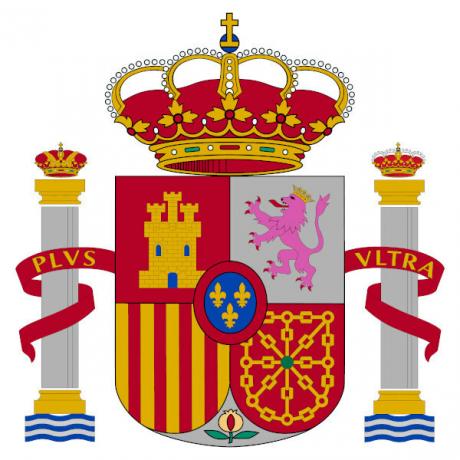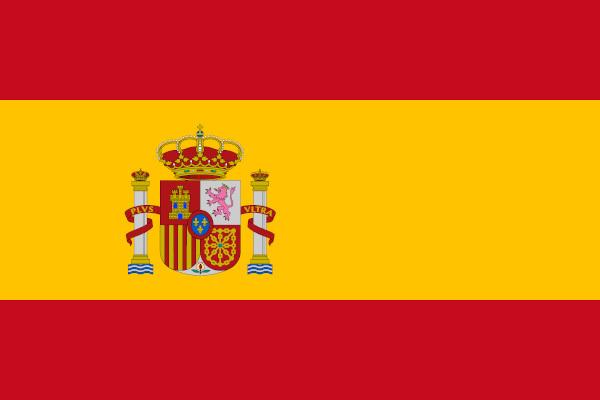A Spanish flag It is one of the country's national symbols. It is made up of two red horizontal stripes interspersed with a thicker yellow stripe, on which is positioned, on the left, the coat of arms of the Spain, which represents their different kingdoms. The current Spanish flag was officially adopted in 1981, and, in addition to it, there are other flags in force in the country, such as the standard of the King of Spain.
Read too: Flag of Argentina — the history of the flag that has the Sun of May in its center
Topics of this article
- 1 - Summary about the flag of Spain
-
2 - Meaning of the flag of Spain
- Meaning of the colors of the flag of Spain
- Meaning of the coat of arms of Spain
- 3 - History of the flag of Spain
- 4 - Other current flags
- 5 - General information about Spain
- 6 - Curiosities about the flag of Spain
Abstract about the flag of Spain
- The flag of Spain is one of the country's national symbols.
- Its current version was officially adopted in 1981.
- It is composed of three horizontal stripes: two red interspersed by a double yellow stripe.
- On the left, in the yellow band, is the coat of arms of Spain. It represents the union of the various Spanish kingdoms, containing six other coats of arms.
- The colors were used in flags and coats of arms of Spain's previous reigns.
- Another interpretation says that yellow represents riches (gold), and red represents the courage, joy and conquest of the Spanish people.
Spain flag meaning
The flag of Spain is a national symbol of that country. It has a rectangular shape and is formed by three colored horizontal bands, which follow the following order from top to bottom: red, yellow and red. The yellow stripe, which occupies the central position, is twice as thick as the two red stripes, as if they were two overlapping yellow stripes. Both the format of the flag, its dimensions and the sequence of colors present in it are defined in article 4.1 of the Spanish Constitution of 1978.
In the yellow band of the flag, in its left half, the coat of arms of spain. Next, we will understand in detail the meaning of the elements that make up the pavilion of this Iberian country.
Do not stop now... There's more after the publicity ;)
Meaning of the colors of the flag of Spain
Spain flag colors are interpreted in at least two different ways., since there is no official interpretation.
The first one indicates that the colors represent kingdoms that were constituted in the past in the region of the Iberian Peninsula, in the southwest of the European continent, and where today the European and Portuguese territories are constituted. They are: Kingdom of Aragon, Kingdom of Castile, Kingdom of León and Kingdom of Navarre. All of them had banners with the colors represented in the current flag of Spain and which, as we will see below, are present in the coat of arms of the country.
The second interpretation, and perhaps the most popular one, says that the yellow color would represent gold, which goes back to the colonial period, when Spain set up a series of exploitative colonies in Latin America. O red, in turn, would be associated with joy and courage of the Spanish people.
Meaning of the coat of arms of Spain
As defined by the Spanish government itself, the country's coat of arms represents a true summary of Spain's political and territorial history. It is about a composition formed by six coats of arms that represent the ancient kingdoms that were at the head of government in the Iberian peninsula since the middle of the fourteenth century and which, later, gave rise to the countries located in that region, notably the Spain.
The golden castle in the first painting represents the Kingdom of Castile. In the sequence we have the lion represented in magenta, carrying a golden crown, symbol of the Kingdom of Leon. The vertical yellow and red stripes in the third frame represent the Kingdom of Aragon. The gold chains with an emerald in the center and represented on a red background in the last painting, in the lower right corner, are the coat of arms of the Kingdom of Navarre.
At the center of the figure that brings together these four coats of arms, there are the yellow fleurs-de-lis painted on a blue background, representing the House of Bourbon, which makes up the current monarchy Spanish. Let us remember here that the Form of government prevailing in that country is the parliamentary monarchy.
The Kingdom of Granada is represented in the lower part of the shield, with a symbol that represents a pomegranate on a gray background. Above them all, there is a golden crown ornamented with precious stones, symbolizing the Spanish monarch. In a strip that runs through the center of the Spanish coat of arms and is superimposed on the side columns, the Pillars of Hércules, reads the Motto of the country: Plus ultra, from the Latin “beyond”.

Flag History of Spain
The current flag of Spain was inspired by the flags of the Spanish merchant and war navies, which operated during the reign of Charles III, in the second half of the 18th century. The monarch wanted the country's flag to be quite distinct from those of other territories, thus being easy to identify when on the high seas.
Thus, in 1785, Charles III asked Antonio Valdés y Bazán, his then minister of the navy, to design a flag as desired. In all, the minister created 12 different models, and Carlos III chose one of them to be the flag of the Spanish navy.
The selected flag was one of the predecessors of the current flag that represents Spain, and, although created under Charles III, it only stopped being exclusively maritime to be adopted as the official flag in the year 1843, during the reign of Isabella II of Spain. A year later, the flag began to be seen on land buildings unrelated to the Spanish navy.
Since Charles III, the flag colors of Spain have been predominantly yellow and red, and so remained even during the republican period and the Francoist dictatorship, which lasted from 1939 to 1975. In the meantime, the bands of the flag of Spain were adopted in the way they are currently arranged, but in place of the coat of arms was the black eagle of São João, which became a symbol of the dictatorial regime Spanish.
With the end of Francoism, the eagle gave way to the coat of arms of Spain. The flag as we know it today was officially adopted in 1981 by Article 39 of October 28.

Other current flags
In addition to the national flag, there are other flags in force in Spain. Are they:
- Civil flag and state flag;
- Flag of pleasure craft;
- Maritime flag of the Spanish fleet;
- Headdress of the Spanish Air Force;
- Banner of the Princess of Asturias;
- Standard of the King of Spain.
Read too: Flag of France — the meaning of the flag adopted during the French Revolution
General information about Spain
Spain is aeuropean country which extends over 506,000 km² in the southwest region of the continent, in an area known as the Iberian Peninsula. It is bathed by the North Atlantic and the Mediterranean Sea, also bordering Portugal and the France. The country Madrid is its capital, which has a little more than 6.5 million inhabitants. The total population of Spain, in turn, is 46.7 million inhabitants.
The Spanish territory experiences variations of the temperate climate, being influenced sometimes by continentality, sometimes by maritimeity. The relief of the country is formed predominantly by plateaus and plains, being crossed by the Pyrenees mountain range to the north, one of the most important in Europe.
Spain's economy ranks among the top 10 in the world European continent, having shown substantial growth in recent years. The Gross Domestic Product (GDP) of Spain is currently almost 1.6 trillion dollars (IMF, 2022).
The Spanish automobile industry stands out both domestically and internationally, just as tourism plays an important role in the country's revenue generation. Spain is still a large beverage producer such as wine, food, automotive equipment and pharmaceuticals.
O Spanish territory is a multiethnic territory, and that is one of the reasons why at least two geopolitical disputes are unfolding within it. We talk here about issues of Catalonia and the Basque Country, which correspond to autonomous regions located within the limits of Spain and which fight for their independence.
Facts about the flag of Spain
- The flag of Spain is known by the citizens of the country as rojigualda. This word is made up of two others: red = red; tail = yellow, referring to the colors arranged in the pavilion.
- It is flown only from Spanish government buildings.
- In public buildings, houses, shops and other establishments, it can only be placed in a horizontal position.
- All Spanish citizens over the age of 18 and with no legal disputes with the country can declare their loyalty to the flag in a solemn act called “Jura de bandera”. The organization of the act is the responsibility of the armed forces.
By Paloma Guitarrara
Geography Teacher
Click to read our text about the flag of Argentina and learn about the history of this important national symbol for the country. Understand the meaning of the Sun of May.
Read our text about the flag of France and understand the meaning of this important national symbol. Discover how the flag was created and some curiosities.
Click and learn about the history of the flag of England, an important national symbol of the country. Compare it with the flag of the United Kingdom and find out the main differences.
Access and learn about the history of the flag of Mexico! Know the meaning of its colors and learn about the symbology of the Mexican coat of arms. See some curiosities.
Surely you have noticed that the flag of Brazil has some stars. But do you know what their meaning is? Click and check!


